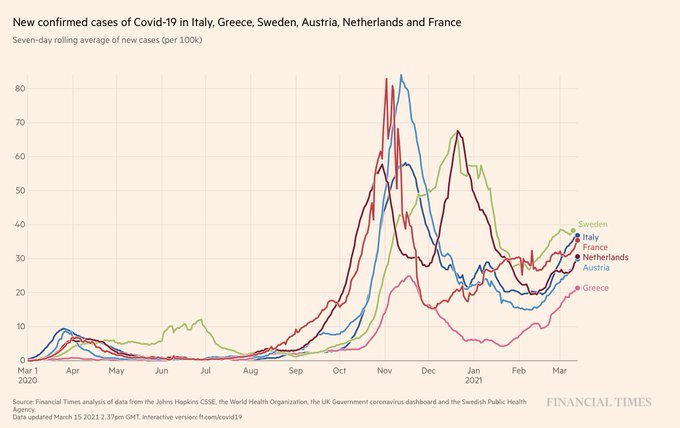SARS-CoV-2 Update for March 15th
The decline in cases has slowed but vaccinations, re-openings, and optimism all continue to surge. All signs suggest we are near, but not at, the end.
The Counterpoint is a newsletter that uses both analytic and holistic thinking to examine the wider world. My goal is that you find it ‘worth reading’ rather than it necessarily ‘being right.’ Expect regular updates on the SARS-CoV-2 pandemic as well as essays on a variety of topics. I appreciate any and all sharing or subscriptions.
There have been 29,439,390 confirmed cases of COVID-19 in the United States. The seven-day average of daily cases is 62,812, an increase since last week, but due to a data dump on 12th (below). Adjusting the data suggests the seven-day average of daily cases continues to decrease, but at a slower rate than previous declines.
National declines in cases have slowed because some states are reporting increases. Two such states, Maryland and New Jersey, are shown below. To be clear, these increases are small and the majority of states continue to report declines. But exponential waves start small and continue to build unless intervened on by public health measures. And with no restrictions on interstate travel, rising case counts in any one state can be easily ‘exported’ to the other 49. TSA just reported four straight days of >1M airport travelers, the first time this has happened since March 2020.
(With COVID Tracking Project no longer reporting daily numbers, these graphs are directly from the CDC).
Multiple hard-hit nations are currently experiencing yet another wave (below). Italy has just entered another lockdown.
These Northern Hemisphere waves are not isolated to Europe. A broad swath of countries are reporting increases in cases (below). This is highly suggestive that seasonality is not the dominant factor influencing viral spread.
These waves are most likely caused by the continued global spread of B.1.1.7 and other variants of concern. A map of the earliest date of detection is shown below (source). It is firmly established that B.1.1.7 is more transmissible. Unfortunately, research continues to suggest that it is more lethal. Previous studies already suggested this but the body of evidence continues to build. In the latest, published today in Nature, an international team suggests that B.1.1.7’s relative risk of death is 55% higher! On an absolute basis, this means that if the population-level infection fatality rate for ‘wild-type’ SARS-CoV-2 is ~0.6%, then the population-level IFR for B.1.1.7 is ~0.9%.
Despite these ominous signs, I remain cautiously optimistic. The only thing that can stop a highly infectious disease is stringent public health measures. In 2020, the United States mostly failed to implement non-pharmaceutical interventions (or at minimum, take them seriously enough). In 2021, we seem intent on premature rollback of such measures. Fortunately, we are one of the few countries with an ‘ace up our sleeves:’ vaccines.
Compare the previously shown countries’ increases to the continued decreases in cases seen in Israel, the United Kingdom, the United Arab Emirates, and the United States.
Occam’s Razor: the simplest explanation tends to be the best one. And here the explanation is really simple: the vaccines work! Every country shown thus far is in the North Hemisphere. Every country with declining cases has administered >30 vaccine doses per 100 people while every country with increasing cases has administered <20 vaccine doses per 100!
And when I say the vaccines work, it is essentially impossible to overstate how much they really work! Pfizer announced the results of their real-world data from Israel, and they report a 97% effectiveness at preventing symptomatic disease. Moreover, they’ve found a 94% effective at preventing asymptomatic transmission! Truly phenomenal results.
To pile on the positive vaccine news, this week, Novavax released the results of their Phase III trials that took place in the UK and in South Africa (read ‘places with variants of concerns’). The results speak for themselves (below). Their vaccine will likely be the fourth authorized vaccine within the United States, joining Pfizer, Moderna, and Johnson & Johnson.
Vaccinations within the United States continue to scale. The seven-day average of daily vaccinations has climbed to 2.39 million. In total, ~136 million doses have been distributed and ~107 million have been administered, for a total administration rate of 78.8%.
Unfortunately, our vaccine reserves continue to build! There are ~29 million doses sitting in freezers ready to be administered (below). Requirements for vaccination need to be greatly reduced, if not outright removed. President Biden has directed states to remove all eligibility requirements for adults by May 1st and today, Mississippi became the first state to comply.
I hope that this update has been both optimistic and ominous. While the United States is in a better position than the vast majority of the rest of the world, the pandemic isn’t over yet. We must continue to be vigilant; the rest of the Northern Hemisphere shows what happens if you don’t take public health measures seriously, both non-pharmaceutical interventions and vaccinations. Seasonality effects have not yet arrived to bail us out yet. Our simple model suggests ~143 million Americans have immunity (below), well below the ~220 million needed for herd-immunity. (With the rise of more transmissible variants, the herd-immunity threshold is likely higher).
As Dr. Tom Frieden, former Director of the CDC, tweeted last weekend, “it ain’t over ‘til it’s over.” The whole thread is worth reading.

If you enjoyed The Counterpoint, please share, subscribe, or comment below.














